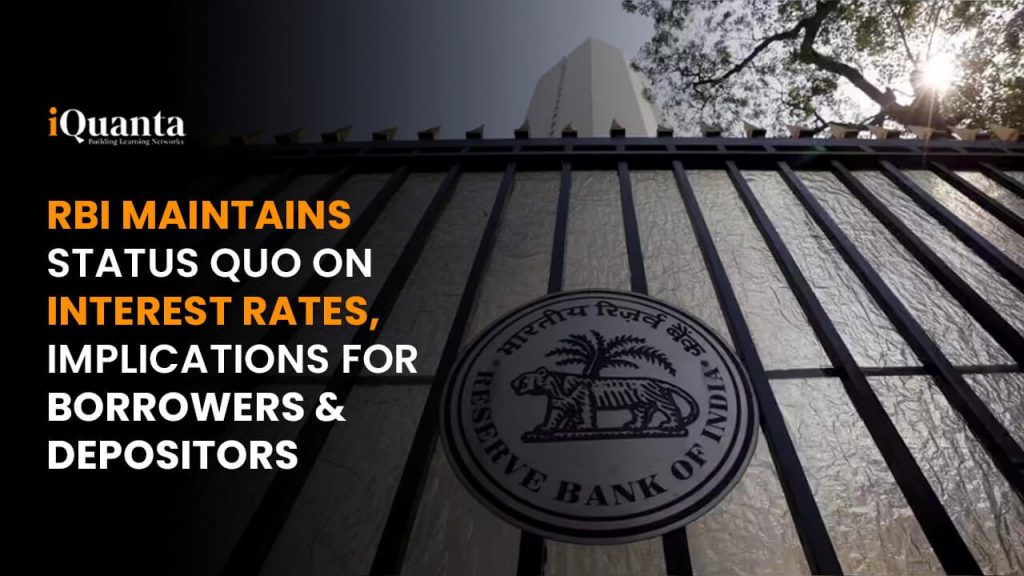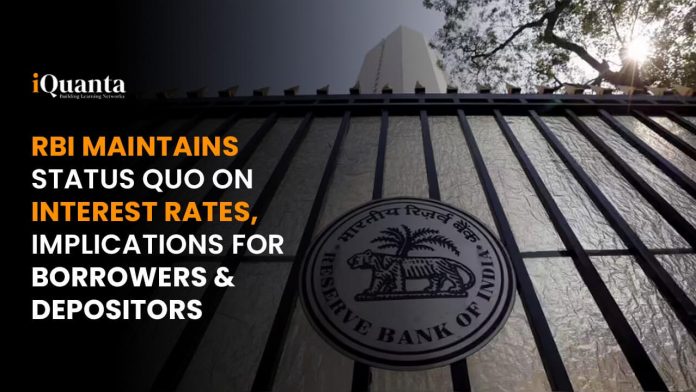
Genre : Economics
In a pivotal decision, the Reserve Bank of India (RBI) has chosen to keep key interest rates unchanged for the fourth consecutive time. This announcement, made by the six-member Monetary Policy Committee (MPC) led by RBI Governor Shaktikanta Das, has far-reaching implications for both borrowers and depositors. The move is rooted in concerns about inflation posing a significant risk to macroeconomic stability and sustainable growth.
Despite growing calls for a rate cut, the MPC has maintained a policy stance of ‘withdrawal of accommodation’ by a majority 5:1 decision. Additionally, the committee has retained the inflation projection at 5.4 percent for the fiscal year 2024, highlighting the persistence of high food inflation. This projection signals that a rate cut is unlikely in the near future, further impacting the financial landscape.

The decision to pause the Repo rate, the rate at which the RBI lends money to banks for their short-term funding needs, has been in effect since May 2022 when the RBI began hiking the rate to combat inflation. In an unusual move during the April policy review, the MPC unanimously decided to halt the rate hike cycle. However, the transmission of monetary policy changes to lending rates remains incomplete, even after a 250 basis point reduction in the Repo rate. Headline inflation is expected to remain above five percent and may even touch 6.2 percent in the second quarter of this year.

RBI Governor Shaktikanta Das cited several factors contributing to the uncertainty surrounding the inflation outlook. These factors include a decline in kharif sowing, lower reservoir levels, and volatile global food and energy prices. Furthermore, recurring incidents of significant food price shocks can exacerbate general inflation trends.
For borrowers, the decision to maintain the policy rate offers temporary relief. External benchmark lending rates (EBLR), linked to the Repo rate, will not rise, providing stability to equated monthly instalments (EMIs) for home, vehicle, and personal loans. EBLRs, which make up 81 percent of outstanding floating rate loans, have become the dominant choice for borrowers, accounting for 48.3 percent of loans by December 2022. Conversely, rates based on the marginal cost of fund-based lending rate (MCLR) have decreased to 46 percent.
Depositors will also see no increase in fixed deposit rates due to the pause in the Repo rate. The decision to maintain deposit rates at current levels is influenced by the surplus liquidity in the banking system, attributed to improvements in low-cost current account and savings account (CASA) balances following the deposit of Rs 2,000 banknotes.
It is essential to note that the RBI’s decision to pause the Repo rate hike should not be interpreted as a departure from its stance of withdrawing accommodation. The central bank remains committed to reducing the money supply to control inflation. Governor Das hinted at the possibility of additional open market operations (OMOs) to manage liquidity in the system.
For existing and prospective homebuyers, the continuity of relatively higher monthly instalments remains a reality. However, borrowers may explore options for refinancing their existing debts and evaluating fixed-rate loans if the long-term cost-benefit analysis proves favorable.
The RBI’s steadfast commitment to the ‘withdrawal of accommodation’ stance is rooted in the need to address inflation risks comprehensively. An accommodative stance signifies the central bank’s readiness to expand the money supply to stimulate economic growth, while withdrawal of accommodation implies a reduction in the money supply to curb inflation. The withdrawal of Rs 2,000 notes from circulation is part of this strategy, with the banking system receiving a substantial portion of the withdrawn currency.
Looking ahead, inflation continues to be a formidable challenge for the Indian economy, with rates standing at 6.8 percent. While a decline is expected in September and October, concerns linger about Kharif crop output, particularly regarding pulses, which could potentially drive prices higher. Frequent food price shocks pose a risk to anchoring inflation expectations, a process initiated in September 2022.
Retail inflation did ease to 6.83 percent in August from a 15-month high of 7.44 percent in July but remains above the RBI’s comfort zone of 2-6 percent. Challenges persist due to food inflation and rising global crude oil prices. Since August 10th, international crude oil prices have averaged nearly $89 per barrel, exceeding the $85 per barrel considered in RBI estimates in April 2023. The recent surge in crude oil prices and global bond yields necessitates the MPC’s vigilance in managing inflation-growth dynamics.
As the RBI’s policies continue to evolve in response to the complex economic landscape, borrowers and depositors must remain attentive to changing interest rate dynamics and their financial implications.
If any of the exams you’re preparing for concerns General Awareness (MBA, UPSC, GDPI, etc.), you can go for iQuanta’s GK Course.


